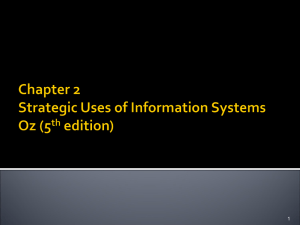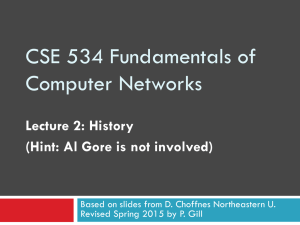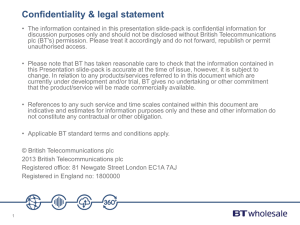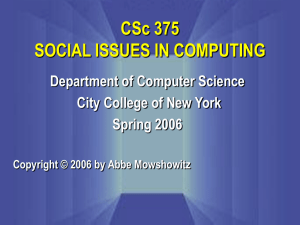+ x - Cambridge University Press
advertisement
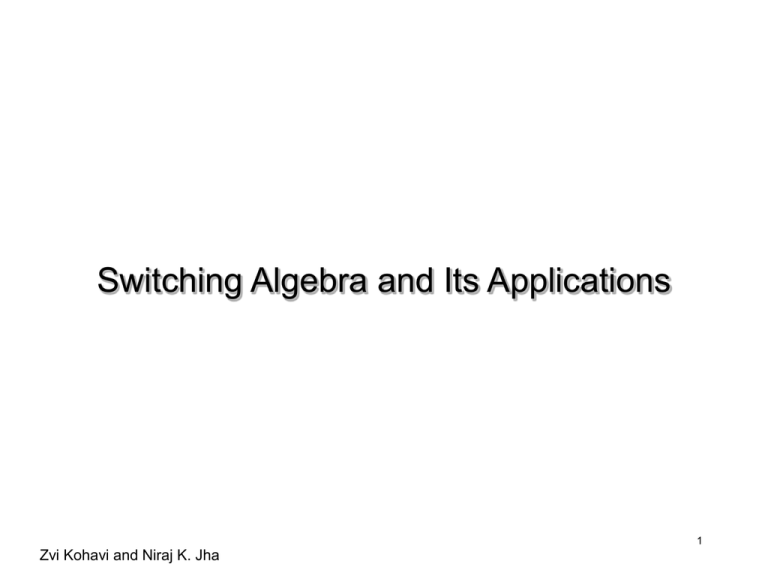
Switching Algebra and Its Applications
1
Zvi Kohavi and Niraj K. Jha
Switching Algebra
Basic postulate: existence of two-valued switching variable that takes two
distinct values 0 and 1
Switching algebra: algebraic system of set {0,1}, binary operations OR and
AND, and unary operation NOT
OR operation
0+0=0
0+1=1
1+0=1
1+1=1
AND operation
0.0=0
0.1=0
1.0=0
1.1=1
NOT operation (complementation): 0’ = 1 and 1’ = 0
OR: also called logical sum
AND: also called logical product
2
Basic Properties
Idempotency: x + x = x
x.x=x
Perfect induction: proving a theorem by verifying every combination of
values that the variables may assume
Proof of x + x = x: 1 + 1 = 1 and 0 + 0 = 0
If x is a switching variable, then: x + 1 = 1
x.0=0
x+0=x
x.1=x
Commutativity: x + y = y + x
x.y=y.x
3
Basic Properties (Contd.)
Associativity: (x + y) + z = x + (y + z)
(x . y) . z = x . (y . z)
Complementation: x + x’ = 1
x . x’ = 0
Distributivity: x . (y + z) = x . y + x . z
x + y . z = (x + y) . (x + z)
Proof by perfect induction using a truth table:
4
Basic Properties (Contd.)
Principle of Duality:
• Preceding properties grouped in pairs
• One statement can be obtained from the other by interchanging
operations OR and AND and constants 0 and 1
• The two statements are said to be dual of each other
• This principle stems from the symmetry of the postulates and definitions
of switching algebra w.r.t. the two operations and constants
• Implication: necessary to prove only one of each pair of statements
5
Switching Expressions and Their
Manipulation
Switching expression: combination of finite number of switching variables
and constants via switching operations (AND, OR, NOT)
• Any constant or switching variable is a switching expression
• If T1 and T2 are switching expressions, so are T1’, T2’, T1+T2 and T1T2
• No other combination of constants and variables is a switching expression
Absorption law: x + xy = x
x(x + y) = x
Proof: x + xy = x1 + xy [basic property]
= x(1 + y) [distributivity]
= x1 [commutativity and basic property]
= x [basic property]
6
Laws of Switching Algebra
Another important law: x + x’y = x + y
x(x’ + y) = xy
Proof: x + x’y = (x + x’)(x + y) [distributivity]
= 1(x + y) [complementation]
= x + y [commutativity and basic property]
Consensus theorem: xy + x’z + yz = xy + x’z
(x + y)(x’ + z)(y + z) = (x + y)(x’ + z)
Proof: xy + x’z + yz = xy + x’z + yz1
= xy + x’z + yz(x+x’)
= xy(1 + z) + x’z(1 + y)
= xy + x’z
7
Switching Expression Simplification
Literal: variable or its complement
Redundant literal: if value of switching expression is independent of literal
xi then xi is said to be redundant
Example: Simplify T(x,y,z) = x’y’z + yz + xz
x’y’z + yz + xz = z(x’y’ + y + x)
= z(x’ + y + x)
= z(y + 1)
= z1
=z
Thus, literals x and y are redundant in T(x,y,z)
Important note: Since no inverse operations are defined in Switching
Algebra, cancellations are not allowed
• A + B = A + C does not imply B = C
• Counterexample: A = B = 1 and C = 0
• Similarly, AB = AC does not imply B = C
8
De Morgan’s Theorems
Involution: (x’)’ = x
De Morgan’s theorem for two variables:
(x + y)’ = x’ . y’
(x . y)’ = x’ + y’
Proof by perfect induction:
De Morgan’s theorems for n variables:
[f(x1, x2, …, xn, 0, 1, +, .)]’ = f(x1’, x2’, …, xn’, 1, 0, ., +)
9
Simplification Examples
Example: Simplify T(x,y,z) = (x + y)[x’(y’ + z’)]’ + x’y’ + x’z’
(x + y)[x’(y’ + z’)]’ + x’y’ + x’z’ = (x + y)(x + yz) + x’y’ + x’z’
= (x + xyz + yx + yz) + x’y’ + x’z’
= x + yz + x’y’ + x’z’
= x + yz + y’ + z’
= x + z + y’ + z’
= x + y’ + 1
=1
Thus, T(x,y,z) = 1, independently of the values of the variables
Example: Prove xy + x’y’ + yz = xy + x’y’ + x’z
• From consensus theorem, x’z can be added to LHS
• Consensus theorem can be applied again to first, third and fourth terms in
xy + x’y’ + yz + x’z to eliminate yz and reduce it to RHS
10
Switching Functions
Let T(x1, x2, …, xn) be a switching expression:
• Since each variable can assume 0 or 1, 2n combinations are possible
Determining the value of an expression for an input combination:
Example: T(x,y,z) = x’z + xz’ + x’y’
T(0,0,1) = 0’1 + 01’ + 0’0’ = 1
Truth table for T
11
Switching Function (Contd.)
Switching function f(x1, x2, …, xn): values assumed by an expression for all
combinations of variables x1, x2, …, xn
Complement function: f’(x1, x2, …, xn) assumes value 0 (1) whenever
f(x1, x2, …, xn) assumes value 1 (0)
Logical sum of two functions: f(x1, x2, …, xn) + g(x1, x2, …, xn) = 1 for every
combination in which either f or g or both equal 1
Logical product of two functions: f(x1, x2, …, xn) . g(x1, x2, …, xn) = 1 for
every combination for which both f and g equal 1
12
Switching Function (Contd.)
Illustrating sum, product and complementation of functions:
13
Simplification of Expressions
Example: Simplify T(x,y,z) = A’C’ + ABD + BC’D + AB’D’ + ABCD’
• Apply consensus theorem to first three terms -> BC’D is redundant
• Apply distributive law to last two terms -> AD’(B’ + BC) -> AD’(B’ + C)
• Thus, T = A’C’ + A[BD + D’(B’ + C)]
Example: Simplify T(A,B,C,D) = A’B + ABD + AB’CD’ + BC
•
•
•
•
•
•
•
A’B + ABD = B(A’ + AD) = B(A’ + D)
AB’CD’ + BC = C(B + AB’D’) = C(B + AD’)
Thus, T = A’B + BD + ACD’ + BC
Expand BC to (A + A’)BC to obtain T = A’B + BD + ACD’ + ABC + A’BC
From absorption law: A’B + A’BC = A’B
From consensus theorem: BD + ACD’ + ABC = BD + ACD’
Thus, T = A’B + BD + ACD’
14
Canonical Forms
Deriving an expression from a truth table:
• Find the sum of all terms that correspond to combinations for which
function is 1
• Each term is a product of the variables on which the function depends
• Variable xi appears in uncomplemented (complemented) form in the
product if has value 1 (0) in the combination
Truth table for f = x’y’z’ + x’yz’ + x’yz + xyz’ + xyz
15
Canonical Sum-of-products
Minterm: a product term that contains each of the n variables as factors in
either complemented or uncomplemented form
• It assumes value 1 for exactly one combination of variables
Canonical sum-of-products: sum of all minterms derived from combinations
for which function is 1
• Also called disjunctive normal expression
Compact representation of switching functions: (0,2,3,6,7)
16
Canonical Product-of-sums
Maxterm: a sum term that contains each of the n variables in either
complemented or uncomplemented form
• It assumes value 0 for exactly one combination of variables
• Variable xi appears in uncomplemented (complemented) form in the sum
if it has value 0 (1) in the combination
Canonical product-of-sums: product of all maxterms derived from
combinations for which function is 0
• Also called conjunctive normal expression
Compact representation of switching functions: (1,4,5)
f = (x + y + z’)(x’ + y + z)(x’ + y + z’)
17
Shannon’s Expansion to Obtain
Canonical Forms
Shannon’s expansion theorem:
f(x1, x2, …, xn) = x1 . f(1, x2, …, xn) + x1’ . f(0, x2, …, xn)
f(x1, x2, …, xn) = [x1 + f(0, x2, …, xn)] . [ x1’ + f(1, x2, …, xn)]
Proof by perfect induction: Plug in x1 = 1 and then x1 = 0 to reduce RHS to
LHS
Shannon’s expansion around two variables:
f(x1, x2, …, xn) = x1x2f(1, 1, x3,…, xn) + x1x2’f(1, 0, x3, …, xn)
+ x1’x2f(0, 1, x3, …, xn) + x1’x2’f(0, 0, x3, …, xn)
Similar Shannon’s expansion around all n variables yields the canonical
sum-of-products
Repeated expansion of the dual form yields the canonical product-of-sums
18
Simpler Procedure for Canonical Sum-ofproducts
1. Examine each term: if it is a minterm, retain it; continue to next term
2. In each product which is not a minterm: check the variables that do not
occur; for each xi that does not occur, multiply the product by (xi + xi’)
3. Multiply out all products and eliminate redundant terms
Example: T(x,y,z) = x’y + z’ + xyz
= x’y(z + z’) + (x + x’)(y + y’)z’ + xyz
= x’yz + x’yz’ + xyz’ + xy’z’ + x’yz’ + x’y’z’ + xyz
= x’yz + x’yz’ + xyz’ + xy’z’ + x’y’z’ + xyz
Canonical product-of-sums obtained in a dual manner
Example:
T = x’(y’ + z)
= (x’ + yy’ + zz’)(y’ + z + xx’)
= (x’ + y + z)(x’ + y + z’)(x’ + y’ + z)(x’ + y’ + z’)(x + y’ + z)(x’ + y’ + z)
= (x’ + y + z)(x’ + y + z’)(x’ + y’ + z)(x’ + y’ + z’)(x + y’ + z)
19
Transforming One Form to Another
Example: Find the canonical product-of-sums for
T(x,y,z) = x’y’z’ + x’y’z + x’yz + xyz + xy’z + xy’z’
T = (T’)’ = [(x’y’z’ + x’y’z + x’yz + xyz + xy’z + xy’z’)’]’
Complement T’ consists of minterms not contained in T. Thus,
T = [x’yz’ + xyz’]’
= (x + y’ + z)(x’ + y’ + z)
Canonical forms are unique
Two switching functions are equivalent if and only if their corresponding
canonical forms are identical
20
Functional Properties
Let binary constant ai be the value of function f(x1, x2, …, xn) for the
combination of variables whose decimal code is i. Thus,
f(x1, x2, …, xn) = a0x1’x2’…xn’ + a1x1’x2’…xn + … + arx1x2…xn
Factor ai is set to 1 (0) if the corresponding minterm is (is not) in the
canonical form
Since there are 2n coefficients, each of which can have two values, 0 and
1, there are 2^2n possible switching functions of n variables
Example: Canonical sum-of-products form for two variables
f(x,y) = a0x’y’ + a1x’y + a2xy’ + a3xy
There are 2^22 functions corresponding to the 16 possible assignments of
0’s and 1’s to a0, a1, a2, and a3
21
List of Functions of Two Variables
22
The Exclusive-OR Operation
Exclusive-OR: modulo-2 addition, i.e., A + B = 1 if either A or B is 1, but not
both
Commutativity: A + B = B + A
Associativity: (A + B) + C = A + (B + C) = A +B +C
Distributivity: (AB) + (AC) = A(B + C)
If A + B = C, then
A +C = B
B +C = A
A +B +C = 0
Exclusive-OR of an even (odd) number of elements, whose value is 1, is 0
(1)
23
Functionally Complete Operations
Every switching function can be expressed in canonical form consisting of
a finite number of switching variables, constants and operations
+, ., ’
A set of operations is functionally complete (or universal) if and only if
every switching function can be expressed by operations from this
set
Example: Set {+, ., ’}
Example: Set {+, ’} since using De Morgan’s theorem, x . y = (x’ + y’)’.
Thus, + and ’ can replace the . in any switching function
Example: Set {., ’} for similar reasons
Example: NAND since NAND(x,x) = x’ and NAND[NAND(x,y),NAND(x,y)] =
xy
Example: NOR since NOR(x,x) = x’ and NOR[NOR(x,y),NOR(x,y)] = x + y
24
Isomorphic Systems
Isomorphism: Two algebraic systems are isomorphic if
• For every operation in one system, there exists a corresponding operation
in the second system
• To each element xi in one system, there corresponds a unique element yi
in the other system, and vice versa
• If each operation and element in every postulate of one system is
replaced by the corresponding operation and element in the other system,
then the resulting postulate is valid in the second system
Thus, two algebraic systems are isomorphic if and only if they are identical
except the labels and symbols used to represent the operations
and elements
25
Series-parallel Switching Circuits
Gate: a two-state device capable of switching from one state, which
permits flow of information, to another, which blocks it, and vice
versa
Primed (unprimed) two-valued variable: denotes flowing (blocked)
information
If a gate permits (blocks) the flow of information: literal associated with it
takes value 1 (0)
Elementary series-parallel switching circuits
x
x
y
y
Parallel connection x + y
Series connection xy
Series-parallel circuits: any circuit constructed of either a series or parallel
connection of two or more elementary series-parallel circuits
26
Transmission Function
Transmission function for a circuit: assumes value 1 (0) when there is
(there is not) a path from one terminal of the circuit to the other
through which information flows
Definition of transmission functions
Analogy: OR <-> parallel; AND <-> series
Complement of a given circuit: one that blocks all paths of information flow
whenever the given circuit permits any
Thus, algebraic system for switching circuits isomorphic to switching algebra
27
Switching Circuit Simplification
y
x
y
x
x
z
z
y
Circuit realizing T = xy’ + (x’+ y)z
Simplified circuit realizing
T = xy’ + x’z + yz
= xy’ + x’z + y’z + yz
= xy’ + x’z + z
= xy’ + z
Important application of theory of switching circuits: CMOS
28
Propositional Calculus
Proposition: declarative statement which may be either true or false
Example: temperature is 100 degree Celsius
turtle runs faster than the hare
sum of 2 and 3 equals 5
Proposition variable: 1 (0) if proposition is true (false)
Negation p’ of proposition p: 1 (0) if p is 0 (1)
Conjunction of propositions p and q is pq: true when both p and q are true
and false whenever either one or both p and q are false
Disjunction of propositions p and q is p + q: true when either p or q or both
are true and false whenever both p and q are false
29
Propositional Calculus (Contd.)
Definition of conjunction and disjunction of p and q
Analogy: OR <-> disjunction; AND <-> conjunction
Thus, algebraic system for switching circuits is isomorphic to propositional
calculus
30
Propositional Calculus Example
Example: Air-conditioning of a storage warehouse to be turned on if one or
more of the following three conditions occurs:
1. Weight of stored material is less than 100 kg, relative humidity is at least
60%, and temperature is above 60 degrees Celsius
2. Weight of stored material is 100 kg or more and temperature is above 60
degrees Celsius
3. Weight of the stored material is less than 100 kg and the barometer
stands at 30 inches of mercury or over
A: proposition that air-conditioning is turned on
W: weight of 100 kg or more
H: relative humidity of at least 60%
T: temperature above 60 degrees Celsius
P: barometric pressure is 30 inches of mercury or more
A = W’HT + WT + W’P
= HT + WT + W’P
= T(H+W) + W’P
Thus, air-conditioning is on if the temperature
is above 60 degrees Celsius and either the
weight is at least 100 kg or the humidity is at
least 60%, or if the weight is less than 100 kg and
the barometer stands at 30 inches or over
31
Electronic Gate Networks
Electronic gates: generally receive voltages as inputs and produce output
voltages
Precise values of voltages not significant: restricted to value ranges – high
(value 1) and low (value 0)
Electronic gates constructed with two-state switching devices: each
capable of permitting the flow of current or blocking it
To implement arbitrary switching functions: gates must be able to
implement a functionally complete set of operations
a
b
c
T1 = abc
a
b
c
T2 = a+b+c
(a) AND gate.
a
(b) OR gate.
T3 = a
(c) NOT gate.
Functionally complete set
32
Gate Network for Air-conditioning
Function
T
H
W
A = T(H+W)+W P
W
P
33
Boolean Algebras
Boolean algebra B: a distributive and complemented lattice
• A set of elements a, b, c, …, and binary operations + and . that satisfy the
idempotent, commutative, absorption, and associative laws, and are
mutually distributive
• It contains two bounds, 0 and 1, which are the least and greatest
elements, respectively
• It has a unary operation of complementation, which assigns to every
element in B its complement
Complement a’ of any element a in B is unique, i.e., there exists only
element a’ such that a + a’ = 1 and a . a’ = 0
• Suppose there exists element a which has two complements, b1 and b2,
i.e., a + b1 = 1, a . b1 = 0, a + b2 = 1, a . b2 = 0
• Then b1 = b1 . 1 = b1 . (a + b2) = b1 . a + b1 . b2 = 0 + b1 . b2 = b1 . b2
• Similar arguments show b2 = b1 . b2.
• Thus, b1 = b2, proving the uniqueness of the complement
Complements of elements 0 and 1: since by definition 0 + 0’ = 1, from the
definition of the lub, 0’ = 1. Similarly, 1’ = 0
34
De Morgan’s Theorem
Prove De Morgan’s theorem for two variables:
(a + b)’ = a’ . b’
(a . b)’ = a’ + b’
• We have to show that (a + b)(a’ . b’) = 0 and (a + b) + a’ . b’ = 1
• Applying the distributive law:
(a + b) + a’b’ = (a + b + a’)(a + b + b’) = (b + 1)(a + 1) = 1
• Dual property proved similarly
Definition of a Boolean algebra isomorphic to switching algebra
Example of Boolean
algebra:
35




